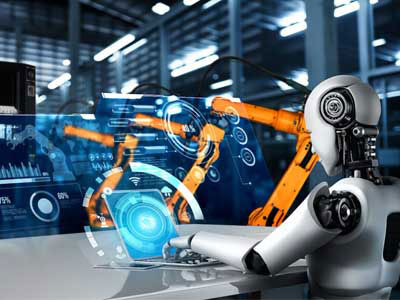Key Takeaway
Industrial robots automate tasks that are repetitive, dangerous, or require precision. These robots are often found in manufacturing settings. They perform jobs like welding, painting, assembly, and packaging. By using sensors and programmed movements, industrial robots ensure high-quality and consistent results. They work quickly and tirelessly, reducing production time and costs. Additionally, robots can handle heavy loads and hazardous materials, keeping human workers safe. Their fixed positions in factories allow them to integrate seamlessly into production lines, enhancing overall efficiency and productivity. Industrial robots are essential in modern manufacturing, ensuring accuracy and safety.
Manufacturing Tasks
In the heart of any factory floor, industrial robots tirelessly execute manufacturing tasks with precision and speed. From repetitive actions like material handling to complex operations such as CNC machining, these robots ensure consistent production outputs. They seamlessly integrate into assembly lines, boosting throughput and maintaining stringent quality standards. Their reliability and efficiency transform industrial processes, enhancing productivity and reducing operational costs.

Assembly and Welding
Imagine stepping onto an assembly line where robotic arms move with precision, effortlessly piecing together intricate components. These robots are equipped with advanced sensors and precise programming, enabling them to excel in tasks that demand finesse, such as soldering delicate circuit boards or welding intricate joints. Their ability to adapt to various assembly challenges ensures that each product meets exact specifications, maintaining consistent quality across production lines.
Industrial robots in assembly and welding operations are designed to handle repetitive tasks with unparalleled accuracy. They operate seamlessly, executing programmed routines that involve picking up components, positioning them with micron-level precision, and securing them together through welding processes. This level of precision not only enhances production efficiency but also minimizes defects, reducing rework and ensuring that every product meets rigorous quality standards.
These robots play a crucial role in modern manufacturing environments by automating tasks that are physically demanding or require high levels of accuracy beyond human capabilities. By taking over assembly and welding tasks, they free up human workers for more strategic roles that involve creativity, problem-solving, and overseeing complex operations.
Packaging and Palletizing
As products near completion on the assembly line, industrial robots seamlessly transition into packaging and palletizing roles. They excel in these tasks by efficiently stacking, wrapping, and labeling goods in preparation for shipment. This automation not only speeds up the packaging process but also enhances precision and consistency in packaging quality.
Industrial robots in packaging and palletizing operations are programmed to handle a variety of packaging materials and product types. They use advanced grippers and suction mechanisms to securely handle products of different shapes, sizes, and weights. This versatility allows them to adapt quickly to changing production needs, ensuring uninterrupted workflow and optimal use of warehouse space.
By automating the final stages of production, factories significantly reduce error rates associated with manual handling and packaging. Industrial robots minimize product damage during handling and transport, leading to higher customer satisfaction and lower operational costs. Moreover, their ability to operate around the clock without breaks increases overall production output and efficiency.
Inspection and Quality Control
In the dynamic landscape of industrial manufacturing, the meticulous assurance of product quality stands as a cornerstone upheld by advanced technologies, particularly industrial robots. These mechanical marvels, equipped with an array of sophisticated sensors and driven by cutting-edge AI algorithms, play a pivotal role in scrutinizing every component to ensure adherence to stringent quality standards.
Imagine a scenario where precision is paramount. Industrial robots, with their micron-level precision measuring capabilities, meticulously inspect components for even the minutest defects. This capability not only minimizes defects but also upholds the esteemed reputation of brands worldwide. Through non-destructive testing methods, these robots delve deep into the structural integrity of materials, ensuring that every product leaving the manufacturing line meets impeccable standards.
In essence, industrial robots serve as the sentinels of quality control, seamlessly integrating technology to uphold brand reputation and exceed customer expectations. Their role transcends mere automation; it embodies reliability and precision, essential in industries ranging from automotive manufacturing to electronics.
Handling Hazardous Materials
In hazardous environments where human safety takes precedence, industrial robots emerge as indispensable guardians, adeptly handling a spectrum of dangerous materials—from volatile chemicals to radioactive substances. Their versatility in navigating confined spaces and operating under extreme conditions makes them indispensable in sectors like nuclear energy, pharmaceuticals, and beyond.
Picture a scenario where human intervention poses significant risks. Industrial robots step in, equipped not only to perform tasks with unwavering precision but also to safeguard human workers from potential harm. Their ability to execute intricate operations within hazardous environments mitigates risks significantly, ensuring operational continuity without compromising safety protocols.
Moreover, the agility and adaptability of these robots make them ideal for tasks that demand unparalleled reliability and safety adherence. Whether it’s the meticulous handling of toxic chemicals or the precise manipulation of radioactive materials, industrial robots set the standard for operational excellence in high-risk industries.
Conclusion
Industrial robots epitomize efficiency and technological advancement in manufacturing. Beyond mere automation, they are essential for production excellence. Understanding their roles, from performing manufacturing tasks to handling hazardous materials, highlights their impact on productivity and safety. Embrace their potential, envision a future where innovation and automation converge, and appreciate how robots redefine possibilities, driving modern industry forward. Welcome to the transformative world of industrial automation.
